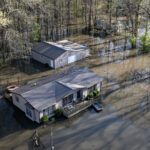Up and down the Atlantic coast, people are telling horror stories about how long it has taken to get an insurance check for flood damage caused by Superstorm Sandy. Nearly 40 percent are still waiting for the final settlements they desperately need to rebuild.
The delays have prompted criticism from officials including New Jersey Gov. Chris Christie, who has blamed the bottlenecks partly on “excessive paperwork” requirements of the National Flood Insurance Program.
But federal data suggest that the speediness, or sluggishness, of the process may be linked to which insurance company is handling your claim. Three and a half months after the Oct. 29 storm, some of the private-sector companies that service flood insurance policies for the government program have paid out on nearly all of their claims by now, while others have yet to hit the halfway mark.
Selective Insurance Co. of America, a New Jersey-based carrier hit with 18,599 flood claims after the storm, had been able to settle only 39 percent of those policies as of Feb. 11, according to data collected by the Federal Emergency Management Agency.
By comparison, Allstate Insurance Co. had closed 94 percent of its 16,309 claims, paying out some $718 million to storm victims. That’s far more than the $415 million distributed by Selective.
Selective declined to make anyone available for an interview but said in a written statement that FEMA’s data “does not tell the entire story.” It said certified adjusters were in short supply and had extremely large workloads because of the massive number of claims. Many policyholders, the company said, also “do not understand the coverage,” and were appealing payments unnecessarily.
So far, the National Flood Insurance Program has been hit with more than 138,000 claims related to Sandy. Companies participating in the program have collectively paid out $4.1 billion.
Selective is handling more Sandy-related flood claims than any other company. The bulk of its customers are in hard-hit areas of New Jersey, where claims might be extra-complicated because of the severity of the damage. “Since Sandy, we have been working steadily to quickly and accurately handle claims,” said a statement from the Branchville, N.J.-based company. “Many of our own employees, because we are headquartered in NJ and our largest regional office is in NJ, were impacted by the storm as well.”
The USAA General Indemnity Co. has closed 83 percent of its relatively modest 3,261 Sandy flood claims.
Travelers Group has closed a less-stellar 58 percent of its 18,215 claims, but it also advanced more than $223 million to customers whose settlements have yet to be finalized. When partial payouts are taken into account, it ranks among the companies that paid the most to customers, with a total distribution nearing $602 million. Drawing comparisons between companies isn’t entirely clear-cut. The statistics don’t take into account factors like a company’s mix of business or level of exposure to the storm.
FEMA officials say they have tried to speed the claims process by giving insurers servicing flood policies additional flexibility to make partial payments.
Topics Carriers Data Driven Claims Flood New Jersey
Was this article valuable?
Here are more articles you may enjoy.


 Hartford: 10-Year Analysis Shows Shifts in Common, Expensive Small-Business Claims
Hartford: 10-Year Analysis Shows Shifts in Common, Expensive Small-Business Claims  WTW to Acquire Newfront in Deal Worth Up to $1.3B
WTW to Acquire Newfront in Deal Worth Up to $1.3B  Zillow Deleting Home Climate Risk Scores Reveals Limits of Flood, Fire Data
Zillow Deleting Home Climate Risk Scores Reveals Limits of Flood, Fire Data  State Farm Sued Over Policies Backed by Distressed Insurer PHL
State Farm Sued Over Policies Backed by Distressed Insurer PHL 


